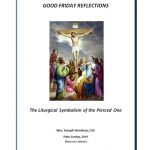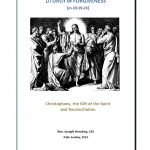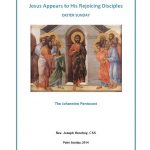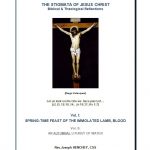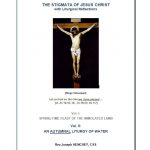A Retreat on the Compendium Rude of St. Gaspar Bertoni
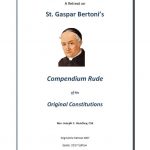 | A Retreat on St. Gaspar Bertoni's Compendium Rude of his Original Constitutions - by Rev. Joseph Henchey, CSS |
As is well known to Stigmatines, the Compendium Rude comprises the first 8 Constitutions of St. Gaspar Bertoni’s Original Constitutions. In these first 8 numbers, there is offered by the Saintly Founder an outline, or a kind of indication, of what the following 300 and more Constitutions present. The introductory part of the Original Constitutions and its style are based on the classics of earlier Doctors of the Church – St. Augustine [Enchiridion] – St. Thomas Aquinas [Compendium Theologiae] – and St. Bonaventure [Breviloquium].
Furthermore, the content of the Compendium Rude imitates a similar composition introducing the Ignatian Original Constitutions, called the Formula of St. Ignatius. This developed from five ‘Chapter’ headings that the Jesuit Founder jotted down: the End of the Society; its Missionary Mode of Obedience; its community Obedience; its Missionary Poverty and a group of miscellanea [no monastic choir; no specific religious habit, following the more exemplary clergy of the time and place. Meditation will be offered on all these elements.
§§§
A Retreat on the Stigmatine Seal
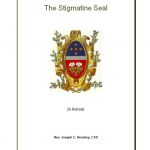 | A Retreat on the Stigmatine Seal - by Rev. Joseph Henchey, CSS |
Much like the Icon of San Damiano, the Stigmatine seal is depicted with the blue of the sky, with its stars, and the seas crossed by the Apostolic Missionary. In the red below there can be depicted the Sacred Stigmata and the Holy Spirit inspiring the community founded by St. Gaspar Bertoni. The silver band in the center can represent in harmony and concord of the members all through life.
§§§
A Stigmatine Retreat on Communion
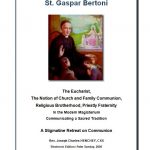 | St. Gaspar Bertoni: The Eucharist, the Notion of Church and Family Communion, Religious Brotherhood, Priestly Fraternity in the Modern Magisterium - by Rev. Joseph Henchey, CSS |
In recent years, the Magisterium of the Church has produced many official documents, teaching the Notion of Communion in the Church herself, in the College of Bishops and the sacramental fraternity of Priests; the fraternal communion religious consecration, and the spousal union of married couples and family communion. These reflections are presented as a possible Stigmatine Retreat, presented with many citations from the writings of St. Gaspar Bertoni.
§§§
A Stigmatine Retreat on On-going Continuing Conversion (Progress)
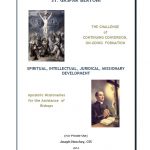 | St. Gaspar Bertoni: The Challenge of Continuing Conversion, On-Going Formation - by Rev. Joseph Henchey, CSS |
Ever since the Second Vatican Council, there has been much interest in the Catholic Church on the constant preparation and betterment of those who are called to serve the Church in her Apostolic Mission. This is the vocation, in different ways, of each one of the baptized.
The Stigmatine Founder, St. Gaspar Bertoni, addressed this matter in his Original Constitutions, which he compiled after his long illnesses forced him to remain for the most par as an invalid the last years of his life. On May 11, 1874, he wrote to his beloved spiritual son, Fr. Louis Bragato, Chaplain of the Royal Hapsburg family in Austria, asking for his prayer for a work that St. Gaspar was composing, ‘drop by drop’, as he described his endeavor.
This present translation of these Original Constitutions also provides in notes the great majority of the ultimate sources the saint used in his undertaking of providing a Rule of Life for the small religious community he founded on November 4, 1816. This rule is the result of their 25 years of the lived community and apostolic experience he shared with the men who followed him.
§§§
Spirituality of the Holy Week
Some imaginative homilists see in Holy Week a sublime celebration of the Eucharist: the entrance Procession of Palm Sunday; the struggle over the Offertory gifts on Holy Thursday night – the separation of the body from the blood on Good Friday – and the combining together of all in the Holy Communion. These reflections see all of life as Offertory – Consecration – and Holy Communion – hopefully in harmony with Pope Benedict’s encyclical, ‘The Sacrament of Charity”: the Eucharist is a mystery in which to believe; a liturgy to celebrate and the Eucharist to be lived.
§§§
The Stigmata of Jesus Christ:
Biblical & Theological Reflections
Stigmata Blood
In the presence of any reflection on the Paschal Mystery, recent theology has been consistent in suggesting a kind of ‘integral’ approach – meaning, the totality of the Mystery: Jesus’ Passion, Death – and – Resurrection, Ascension. In our Stigmatine world, our saintly Founder – St. Gaspar Bertoni – seemed to be well imbued with both dimensions of this mystery: he noted both the ‘Sorrowful” wounds of Good Friday –through which flowed the precious Blood for our salvation – as well as the “Glorious” Dimension [by imparting a special share in His Apostolic Mission on Easter Sunday in Jn 20]], the retention of the Five Sacred Wounds in His risen body [as in his reflections on the Sacred Heart and in his very lengthy commentary on “First Kings”]. In this present, the effort is to present the shedding of the Precious Blood in our Redemption and New Birth, celebrated in the Pasch, in the spring-time of the year.
Stigmata Water
Continuing the ‘integrity’ theme for the entire Paschal Mystery, there is also need to mention the water [Jn 19] flowing from the sacred side of Christ on Calvary. For many, this is a source for the Liturgical Drop of Water in the Chalice containing wine in the Eucharist. In the life of Israel, there was a special festival of the “Ingathering” [harvest] in the autumn of the year: known the Feast of Tabernacles, Tents, Booths. Part of the ceremony involved a procession with water through the Water Gate. This integral mystery remains us that redemption is offered every step of the journey, from the spring-time of life through its autumn experience. The combination of Blood and Water is also epitomized in the Icon of Mercy, celebrated particularly on the Second Sunday of Easter, “Mercy Sunday”.
§§§
A Retreat on St. Gaspar Bertoni’s Commentary on
The First Book of Kings [Samuel]
A Reflection for the Stigmatine Laity’s Day of Recollection
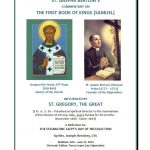 | A Retreat on St. Gaspar Bertoni's Commentary on The First Book of Kings [Samuel], influenced by St. Gregory the Great - by Rev. Joseph Henchey, CSS |
For some years. many thought this long commentary on what is now I Samuel and its first 10 chapters, up until the call of King David, was attributed to St. Gregory the Great. That opinion is not as fully accepted as it once was. However, in St. Gaspar’s time, it most likely was considered to have been the work of Pope St. Gregory the Great. St. Gaspar preached this as Spiritual Director to the Seminarians of the Diocese of Verona, Italy, every week for 30 months [November 1810 – Easter 1813].
The main thrust of this composition is to encourage Priests and Seminarians and to challenge them to live their lives in a more intense spiritual manner. Pope St. Gregory the Great is a “Father of the Church” – and he left a record of his consecration of the present Roman Church called “St. Agatha of the Goths” – which up to 1927 housed the Irish College – and, from 1927 up to this present time, serves as the General House of the Stigmatine Community.
§§§

